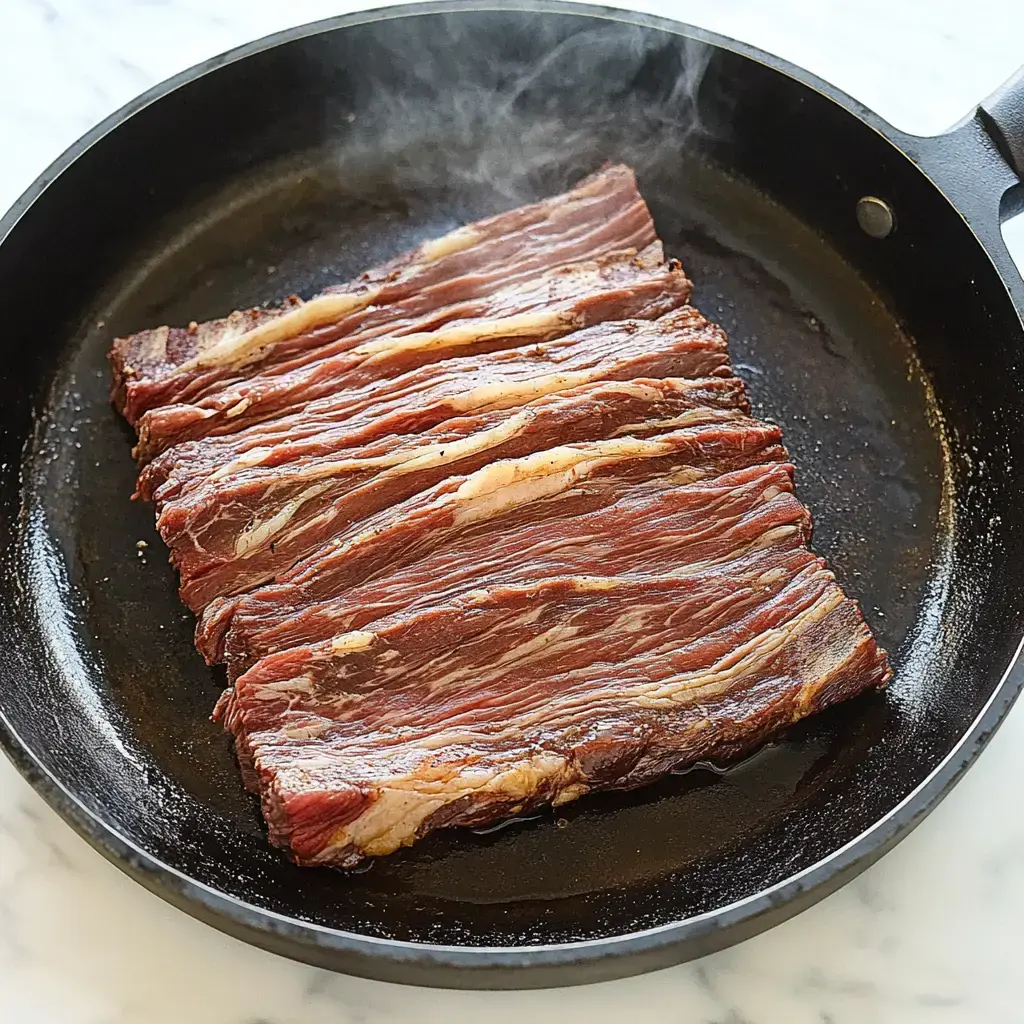 Pin it
Pin it
Looking for top-notch steak without busting your budget? A juicy skirt cut delivers bold taste quickly. If you're a beginner cook or just checking out different beef options, mastering skirt steak will transform your dinners into something special.
Unique Qualities
While everyone rushes for filet or ribeye, skirt steak offers deeper flavor at a friendlier price. Give our marinade a try to make it even more tender. This versatile cut works in everything from salads to tacos.
Required Ingredients
- Oil: Just enough for a proper sear
- Pepper: Freshly ground for best results
- Salt: A healthy sprinkle of kosher
- Fresh Meat: Look for good marbling throughout
Cooking Instructions
- Slice and Serve:
- Find the grain direction - those tiny lines running through the meat. Slice against those lines at a slight angle. Keep your cuts thin, about pencil-width, and dish them up immediately while hot.
- Rest Period:
- This part's crucial - transfer your cooked meat to a board and loosely cover with foil. Wait a full 10 minutes. Your steak needs this break to lock in all those tasty juices.
- Cooking Process:
- Place the meat in carefully - you should hear an immediate sizzle. Push down slightly so the entire surface contacts the pan. Cook for 3-4 minutes until deep brown develops, flip once and go another 3 minutes for medium-rare doneness.
- Heat Your Skillet:
- Get your largest cast iron skillet extremely hot - give it about 3-4 minutes over high flame. Add just a thin layer of oil. When you notice tiny smoke wisps, you're good to go.
- Season Well:
- Thoroughly dry the meat with paper towels - this step's critical for getting that fantastic brown crust. Sprinkle both sides liberally with salt and pepper, gently pressing the seasonings into the meat.
- Initial Preparation:
- Remove your steak from the fridge 30 minutes before you plan to cook. If it's too lengthy, cut into 5-7 inch sections. This helps with even cooking and makes handling easier in your pan.
Understanding The Meat
This underappreciated cut proves its value in countless dishes. Coming from beneath the ribs, there are two varieties: outside (naturally tender) and inside (needs some tenderizing work). Both deliver incredible flavor when you cook them properly.
Cut Differences
Wondering about similar cuts? Flank steak runs wider and thicker, while skirt steak comes long, thin and packs stronger beefy flavor. They're interchangeable in many recipes, but our marinade works especially well with skirt steak's natural structure.
Reliable Results
Fast cooking with intense heat brings out the best in skirt steak. Your pan must be scorching hot, cook it quickly, and don't leave it too long. Aim for medium-rare to keep everything juicy - roughly 3-4 minutes each side works great.
Flavor Boosters
Mix together some olive oil, garlic and herbs for a basic but tasty marinade. Let the meat soak for about 30 minutes - any longer can make the texture too mushy. Dry it thoroughly before cooking to get that gorgeous brown exterior.
 Pin it
Pin it
Serving Ideas
After you've mastered cooking this cut, try it different ways. Go for thin slices in tacos, top off a fresh salad, or pair with oven-roasted veggies. And don't throw away leftovers - they'll make fantastic sandwiches tomorrow.
Frequently Asked Questions
- → How to cook it best?
Screaming hot skillet does wonders. Brief time each side. Keep it still. Wait for that sear. Nothing fancy needed.
- → When's it medium rare?
Get a thermometer reading. Aim for about 130 degrees. Nice red center's good. Always rest it first. Skip rushing the cut.
- → Why let it rest?
Locks moisture inside. Just five minutes works. Cut too early ruins it. The pause matters. Makes tastier bites.
- → Want to soak it first?
That's your call. Basic seasonings work fine. Brief marinade's okay too. Extras aren't necessary. Plain tastes great.
- → How to cut it right?
Against the muscle fibers. Go for skinny pieces. Use your sharpest knife. Find the meat's direction. Improves chewability.
- → Getting too tough?
Watch your cooking time. Mind your temperature. Slice correctly for sure. Give proper resting. Quality meat counts.
- → Taking it places?
Prepare it there if possible. Keep tightly covered. Save cutting till arrival. Bring your best knife. Effort pays off.
- → Need it faster?
Start at room temperature. Skillet extremely hot. Single layer cooking. Short rest works. Still needs minimal time.
- → Making big batch?
Work in smaller groups. Keep cooked portions warm. Never overcrowd. Track timing carefully. Rest each section.
- → Want more flavor?
Try some butter with garlic. Fresh herbs add zip. Fancy salt works well. Even a squeeze of lime. Don't mask beef flavor.
- → Pan not hot enough?
Preheat it longer. Look for wisps of smoke. Try water droplet test. Quality cookware matters. Cast iron beats all.
- → Meat too bloody?
Let it cook slightly more. Use your thermometer. Peek with a cut. Trust what you see. Slightly rare tastes best.
Conclusion
Enjoyed this? Next time grab a chunky ribeye. Or try the wider flank cut. They both need fast, intense heat.
